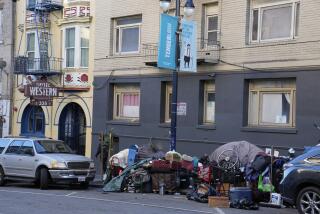Part of Homeless Population : Rails Keep Job-Hungry Hobos on Move
- Share via
HELENA, Mont. — It was 1952, and Vic Wolberg was 13. He couldn’t get along with his dad, so he did what he thought was the sensible thing.
He packed. He hopped a Great Northern Railroad freight in St. Paul, Minn., and headed for Seattle, where he was going to find a job and take care of himself.
It is 36 years later, and Wolberg, still searching, continues to head west and then back east again.
By his own rough count, he has tramped back and forth across what is now Burlington Northern’s Hi-Line at least 40 times since that day he first left home.
Though Wolberg’s pattern has slowed because of a bad leg and a fondness for Montana ranch work, he considers traveling the Hi-Line what he does best.
“When you’re on the road, you’re accomplishing something,” Wolberg said in a recent interview at God’s Love Shelter here. “You have possibilities. You have hope of a job.”
Wolberg is one of hundreds of homeless people who visit Montana’s missions and shelters, but who are not Montanans.
They are people who travel the rails and the highways on a route that takes them somewhere between Seattle and Minneapolis, summer and winter, in good weather and bad, with little more than a bedroll and hope.
Some shelter personnel who deal with the homeless in Montana say this steady migration back and forth across the Northwest is what distinguishes these men and women from the homeless in other parts of the country, particularly those in big cities.
“There is a real frontier spirit among the homeless up here,” said Leigh McCarter, director of the shelter here. “They are not like your average poor street people who can find a grate and wait out their life for a period of time. These are the wagon train people.”
She added: “The difference between these people and some of the homeless in bigger cities is that these people are moving . . . toward hope.”
About half the homeless people she sees each day are traipsing the region in search of work, she said.
“These are people who, if they hear of a job 1,000 miles away, they’ll get up and go.”
Many of Montana’s homeless people are traveling through the state because they have heard of apple-picking jobs in Washington, ranch work in Montana or seasonal farm work in Minnesota.
Some hop Burlington Northern’s Hi-Line; some take Montana Rail Link’s southern line, which cuts through Butte, Livingston, Bozeman and Missoula.
Others go in cars that double as homes. Some walk.
“We’re like a major crossroads for the homeless here, where these people are forever just passing through,” said the Rev. Dallas Doyle of the Butte Rescue Mission.
“They go east and then they go west again. We often see the same people come through our mission in July who came through six months earlier heading in the opposite direction.
“They’re all looking for something they never find.”
Even in winter, transient traffic is steady, he said.
Unclothed in Winter
“We have a lot of people who come into our mission half naked and without shoes on their feet in this weather. We give them some clothing and some food and a bed, and then they’re on their way again, out on the road, looking.”
Joan Graber, director of the Salvation Army office in Havre, said the majority of homeless people she sees are railroad tramps and transients, but she doubts that it is the thought of finding work that keeps them moving.
“I would say about a fourth of the train hobos who come through here repeatedly are looking for work,” she said, “but most are just riding the rails.
“They’re just traditional transients with rail fever. Looking for work might just be some excuse they make up for themselves.”
Wolberg, between trains for the moment, disagreed.
“Sure, there are some out there just out of habit,” he said. “They don’t know anything better, anything different.
“But a lot of us are on the road because we have to find work. The only way we give up is when we drop dead.”
For him, the road is not a place to hide. He said it represents an opportunity to find what he wants--a reasonable job and a decent wage.
“When I’m riding the rails, being a tramp, about 90% of the time I find what I’m looking for,” he said.
“It’s all out there. You just have to find it.”
More to Read
Sign up for Essential California
The most important California stories and recommendations in your inbox every morning.
You may occasionally receive promotional content from the Los Angeles Times.













